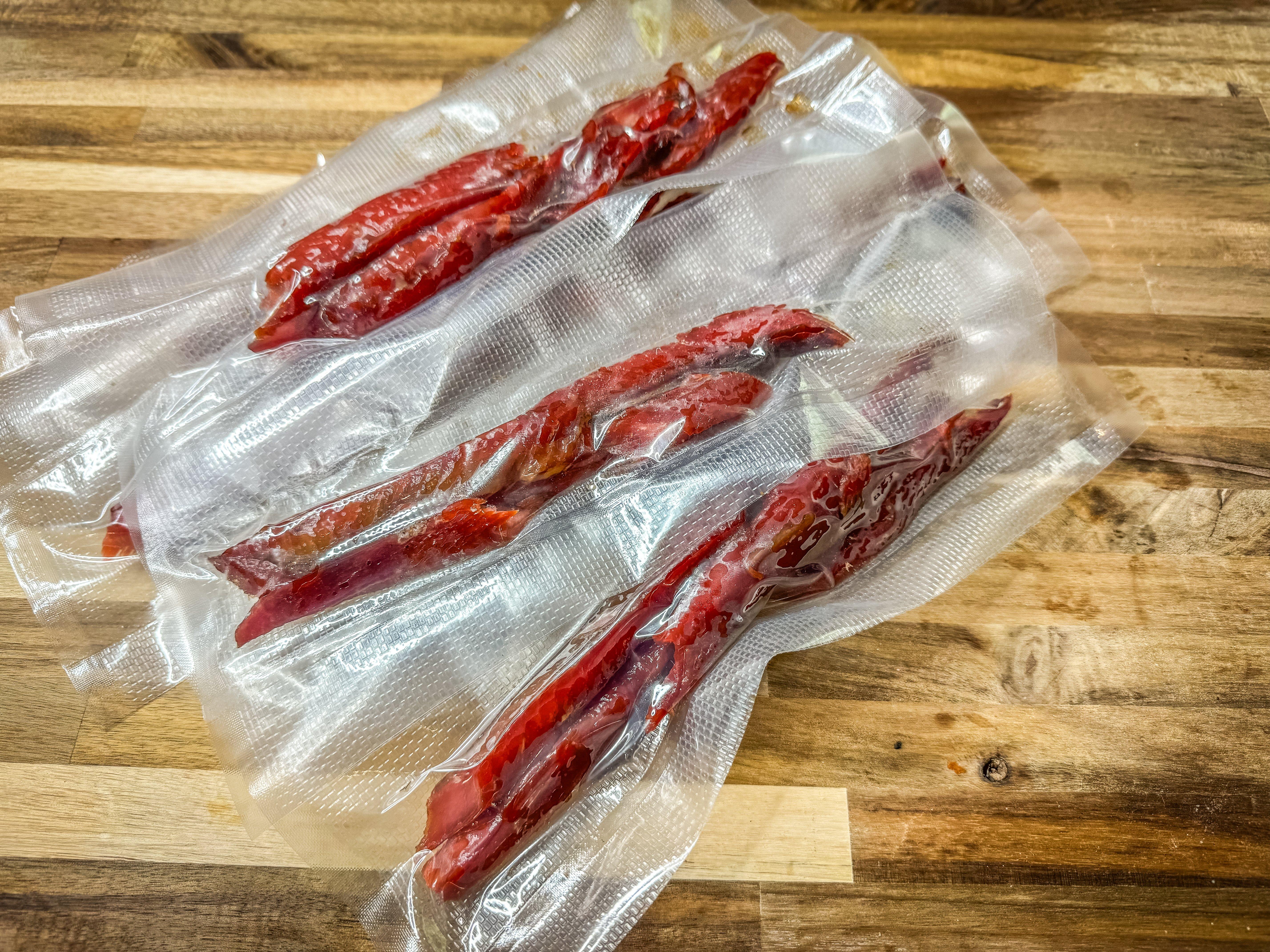Sweet sorghum lends this coastal treat a southern flair
Southern Style Smoked Salmon Candy
30 Min
Prep Time
120 Min
Cook Time
Easy, Medium
Difficulty
I envy those folks who live in coastal fishing areas, either salt water or the Great Lakes. They can mosey down to their favorite fish market and pick up smoked salmon candy just about any time they please. Once a popular way of preserving the catch to prevent starvation over the long winter, smoked fish is now considered a delicacy.

Unless you live in a coastal area, good smoked fish can be hard to find. Luckily, it’s easy to make at home.
But, for us in more geographically challenged locations, good smoked fish is a matter of expensive mail order or DIY at home. Luckily, high quality smoked fish isn’t difficult to make. As long as you have some time and a smoker, you can make it whenever you want.

All you need is some time and a smoker.
This is my favorite recipe for “salmon candy,” a particularly sweet and salty version of smoked fish. I prefer wild caught sockeye salmon for this one when I can get it, but other salmon or even large lake or freshwater trout will work in a pinch.

Wild caught sockeye salmon is my favorite fish for this recipe, but any salmon or large trout will work.
There are countless salmon candy recipes out there. Many use a wet brine, soaking the fish overnight or longer in a salty, sweet liquid, but this one uses a dry brine. For the added sweetness of traditional fish candy, instead of the more common honey or maple syrup, I like to go a more southern flavor route and use a high quality sweet sorghum like Kentucky grown Uncle Josh’s for a different, and slightly unusual flavor, compared to more traditional recipes.
Start with 2-4 pounds of boneless, skinless salmon fillets. If your fish still has pin bones, wait until after it cures to remove them. The bone removal process just seems a bit easier after curing than while fresh.
The basic dry brine for this one is 3 cups brown sugar to 1 cup Kosher salt. Mix the two well in a bowl or bag. Spread a thin layer of the sugar mixture over the bottom of a large glass dish. Pat the fish fillets dry and place in a single layer over the brine. Spread on more of the sugar and salt mixture, covering the fish completely.

Lay the fish fillets in a single layer over a bed of the salt/sugar mixture, then completely cover with additional salt and sugar.
Drizzle on some sorghum molasses, reserving some for a final brush before the fish smokes. Do this in layers if you have more fish than will fit in a single layer in your dish.

Drizzle over some sorghum, reserving some for later in the recipe.
Cover the dish and refrigerate 12-24 hours. Fillets thinner than an inch brine faster, so base the time on the relative thickness of your fish.
Once the fish has brined, discard the caked-on brine, then rinse the fish well under cold water. Pat the fillets dry and place them on a wire rack. In a cool area, place the rack in front of a fan and allow the fish to dry for 2-3 hours, forming a sticky pellicle.
Use tweezers or needle nosed pliers to remove pin bones, if needed. You can find the pin bones by running your finger across the mid section of the fillet and feeling for the points of the bones.

Use tweezers or needle nosed pliers to remove pin bones. A damp paper towel makes a handy spot to deposit the bones.
After bones have been removed, cut the fish into roughly 1 inch wide strips, lengthwise to the fillet.

Slice the cured fish into long strips.
Brush the strips with a thin layer of additional sorghum.

After drying to form a pedicle, brush the fish with additional sorghum before smoking.
Hang the fish or place it on a wire rack in your smoker.

Hang the fish vertically or place on wire racks inside the smoker.
While I like hickory, fruit woods or oak for most meat smoking, when it comes to fish, I go with alder or maple. The mild smoke flavor is the perfect complement to the cured salmon.

Mild smoking woods like alder or maple are perfect for fish.
For fish, I like to break out my Bradley smoker. It’s easy to swap out Bissquettes from one wood choice to the other. With my Bradley, I start the fish on the smoke only mode. If I am smoking in the warm summer temperatures, this is often all I need to get the 150-160 degree temperature I like. If outside temperatures are really hot, I usually leave the top vent fully open and even crack the door a bit to keep the internal temperatures down. After two hours, I turn the temperature up to 200-210 and smoke an additional hour or two or until the fish reaches 160 degrees internal temperature.

Vacuum seal and freeze any leftovers for long term storage.
Eat some of the salmon candy as soon as it comes off the smoker. It’s a flavor explosion. If you have any left, let it cool then vacuum seal it in single serving packs for long term storage. I like to freeze it and bring out a few pieces to stash in my pack for a prime hunting or fishing snack. A stick of fish candy and a few slices of cheese, maybe an apple, and you have a field lunch that will stick with you all day.
Ingredients
2-4 pounds skinless salmon fillets
3 cups brown sugar
1 cup kosher salt
1 cup Uncle Josh or other premium sweet sorghum








